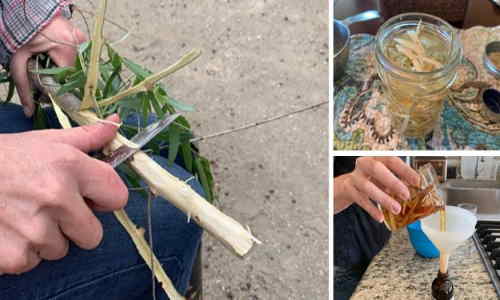
This article was originally published by Alison Borel on www.askaprepper.com
Willow tree bark tincture is a pain reliever that’s easy to make. As the main ingredient found in aspirin, the inner pith of willow bark is nature’s great analgesic.
Knowing which products in our own backyards can relieve pain serves a survivalist well. What if, instead of “taking two aspirin and calling the doctor in the morning”, we just carved a chunk of bark from a willow tree, and made a tincture?
Although tinctures need four weeks to cure, any home herbalist will tell you how deeply satisfying it is to create natural medicine that works as good as (or better than) store-bought varieties.
History Of Willow Bark As A Pain Reliever
Willow bark was the original aspirin. The first recorded use of willow tree bark was found on Sumerian clay tablets dated around 4000 B.C.
Pain, inflammation, and fever reduction were the top three purposes for using willow bark. Salicylic acid is the derivative that performs the pain-relieving action prescribed by aspirin. In fact, the Latin word for willow is actually salicin.
Hippocrates, the Greek father of medicine prescribed willow bark as an analgesic around 400 B.C. He recommended that people suffering from common ailments such as headaches, fevers, and inflammation chew the tree bark as a remedy.
By that same token, Hippocrates also prescribed a strong tea from willow bark to lessen the pain of childbirth.
How Willow Bark Became Aspirin
The Bayer Company first introduced aspirin in 1899. Aspirin was the first semi-synthetic drug ever produced.

Due to the fact that willow bark created stomach aches in some people, scientists isolated the salicin from the rest of the plant. This method created a chemicalized form, known as a modern drug.
The irony here is that some people cannot tolerate aspirin because it causes a tummy ache. But, they can tolerate willow in its base form.
By isolating one ingredient from the rest found in willow bark, side effects that were preventable by using the whole plant were introduced. Perhaps the truth lies in the fact that aspirin or willow bark should not be taken on an empty stomach.
Whatever the case may be, aspirin continues to be the top-selling pain reliever in the world.
Pain-Relieving Willow Bark Tincture
Tinctures are incredibly simple. First, gather an herb and dry it out as best you can. Harvesting plants in the great outdoors is super easy, and they don’t have to necessarily grow on your own property. Luckily, willow grows everywhere except for Australia and Antarctica.
The easiest way to get willow from someone else is to use social media, which when used for this purpose redeems itself. Neighbors love to help one another achieve simple goals, and the best way you can get access to naturally existing products is to simply ask.
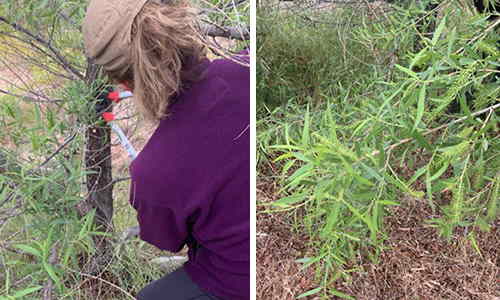
Once you’ve realized where your willow grows, just cut some young branches and literally whittle out the tender pith in the middle.
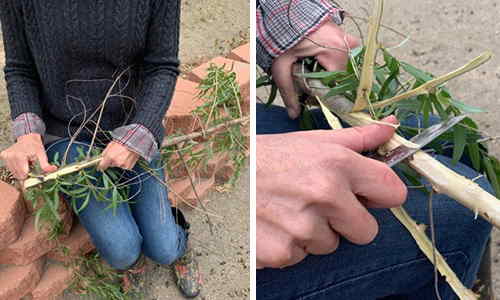
You’ll need enough bark to fill your jar halfway to ⅔ full. I cut out about three young branches from my neighbor’s property.
No need to attack the tree trunk, as the best stuff actually comes from the youngest areas, the easy to get to branches.
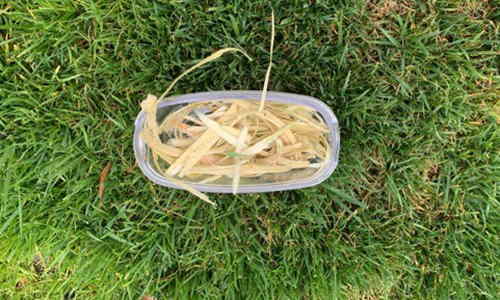
Now spread your new carvings on a paper towel and let it dry out for a day or two. The more dry your herb is, the more potent your tincture will be.

Required Supplies
- 4 or 8 ounce mason jar
- 40% alcohol vodka (80 proof)
- Small brown glass bottle with glass dropper
Choose The Right Alcohol For Your Pain Reliever
In a 1:4 ratio, (one part herb to four parts alcohol), pour the alcohol over the herb in a glass jar. I love using small mason jars for these projects. Just make sure the product doesn’t touch the lid, as the metal can cause an unwanted chemical reaction in your tincture.
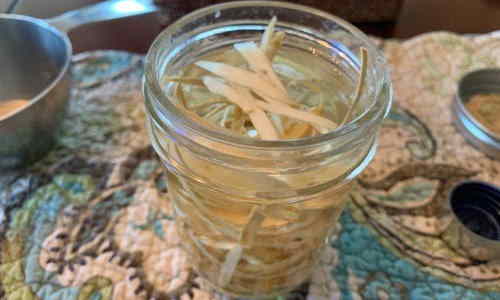
For this project, I went with 80 proof Vodka, which is 40 percent alcohol. If you were to make a tincture using a floral herb such as echinacea, you’d want to go with higher-proof alcohol. This is because flowers are more soluble in alcohol, so getting the strength of medicine to efficacy will require a more potent alcohol.

Luckily, willow is more water-soluble, thereby making lower-proof alcohol an easy choice. If for some reason you go with higher proof alcohol, then let the product stand for less time than is prescribed or simply dilute with water.
Willow tincture needs to stand for three to six weeks before you separate the herb from the alcohol and return the herb to the earth. Squeeze the willow to get as much potency as possible before discarding.
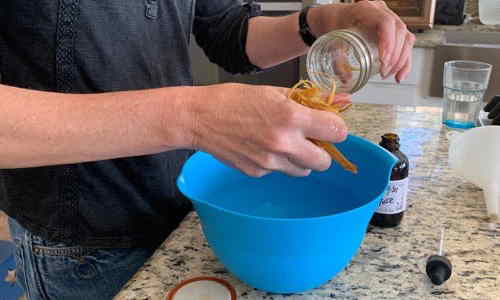
Also, store in a dark cabinet for three to four weeks, ensuring the bark is fully submerged in the vodka.

Now you need to pour the remaining alcohol/mixture into a small brown glass bottle with a glass (not plastic) dropper. Just like the metal lid on the bell jar, plastic will also react unfavorably with an herbal remedy.
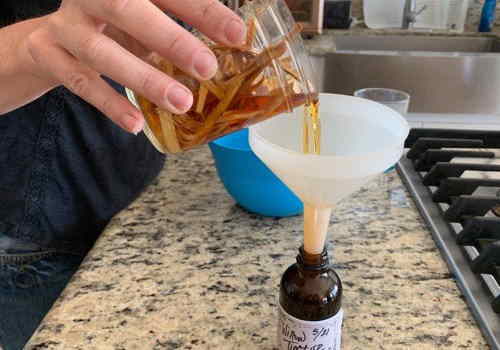
Make sure to label and date the tincture. Once you get started making herbal remedies, you won’t want a bunch of non-labeled bottles cluttering the medicine cabinet.
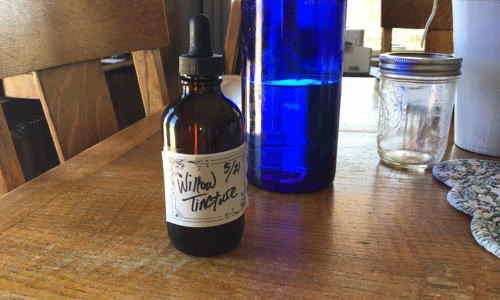
If alcohol is a no-go in your home, then you may alternatively use apple cider vinegar. Allow for six weeks’ rest in order to have a strong result. Then separate the bark from the vinegar and continue with the method.
How And When To Use Willow Tincture
Since this tincture is strong, begin with taking a few drops on your tongue. You can always add more if this isn’t enough.
To use a tincture, fill the dropper with the liquid and drip it into the mouth, just under the tongue. Hold the tincture in your mouth for a few seconds before swallowing. Rinse your mouth thoroughly with water to get rid of the bitter taste.
It’s amazing how a very bad-tasting herbal can taste just fine for someone in need of relief.
Since time immemorial, natural products have been relied upon as the backbone of traditional healing systems. Knowing how to process medicinals that grow in your area is an amazing skill.
As with all new things, a bit of practice here helps. Because of that, we encourage you to try your hand at home remedies on your homestead regularly. When your bottle of aspirin runs out, try taking willow!

MORE ARTICLES :
5 Poisonous Plants That Can Be Used As Medicine When SHTF
This Driveway Weed Has Pain-Killing Properties Similar to Ibuprofen
The States with the Most Medicinal Plants. Do You Live in One of Them?
How to Identify and Use Kratom – the Painkilling Plant that Substitutes Opioids
10 Most Powerful Medicinal Plants Used by Cherokees
Natural Antibiotics With Herbalist Nicole Apelian From Alone
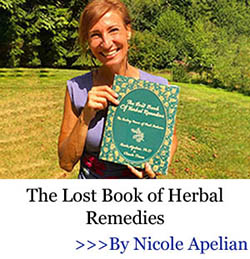
The post How To Make A Pain-Relieving Willow Bark Tincture appeared first on Bio Prepper.
By: Alison Borel
Title: How To Make A Pain-Relieving Willow Bark Tincture
Sourced From: www.bioprepper.com/2021/09/19/how-to-make-a-pain-relieving-willow-bark-tincture/
Published Date: Sun, 19 Sep 2021 06:20:34 +0000
-------------------------------------------------------------------------
Did you miss our previous article...
https://outdoorsnewswire.com/survivalist/so-can-you-eat-squirrels-for-survival
 CampingSurvivalistHuntingFishingExploringHikingPrivacy PolicyTerms And Conditions
CampingSurvivalistHuntingFishingExploringHikingPrivacy PolicyTerms And Conditions
